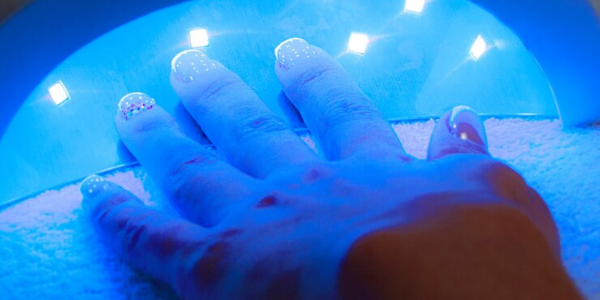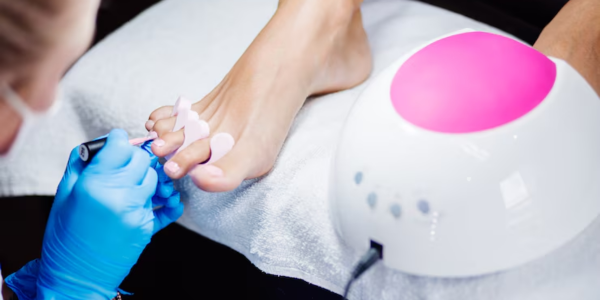How to Treat Toenail Fungus with UV Light
How to Treat Toenail Fungus with UV Light: A Comprehensive Guide

Toenail fungus is a common and frustrating condition that affects many people around the world. It can cause discomfort, discoloration, and a general sense of unease due to its unsightly appearance.
Fortunately, there are a number of treatments available to combat toenail fungus, and one increasingly popular option is the use of UV light therapy.
In this blog post, we’ll delve into how toenail fungus develops, how UV light works, and why it’s a promising treatment for this condition.
We will also explore the benefits, potential risks, and everything you need to know about using UV light to treat toenail fungus.
What Is Toenail Fungus?
Toenail fungus, medically known as onychomycosis, is a fungal infection that affects the toenails. It is caused by fungi that thrive in warm, moist environments, which is why the feet, especially the toenails, are vulnerable.
The fungi responsible for the infection are usually dermatophytes, but yeasts and molds can also be to blame. Toenail fungus can begin as a small spot or patch of discoloration on the nail.
Over time, the fungus can spread, causing the nail to thicken, become discolored, brittle, or even crumble. In some cases, the infection can be painful and cause discomfort while walking.
While toenail fungus is not typically a severe medical condition, it can significantly affect the quality of life, causing embarrassment and a decrease in self-esteem.
If left untreated, it can also lead to secondary infections or complications, particularly for people with compromised immune systems.
How Does Toenail Fungus Develop?
Toenail fungus develops in the following way:
- Infection Initiation: The fungus enters the nail through small cracks or cuts in the nail or surrounding skin. This can happen through contact with infected surfaces or by using shared items, such as shoes or towels.
- Fungal Growth: Once inside the nail, the fungi begin to grow, feeding off keratin (the protein that makes up the nail). The warm, dark, and moist environment of the nail bed is perfect for their growth, allowing the infection to spread.
- Progression: As the infection grows, it causes the nail to thicken, discolor, and become deformed. It may also separate from the nail bed in some cases. In severe cases, the nail may break or crumble.
Conventional Treatments for Toenail Fungus
Traditionally, toenail fungus has been treated using oral antifungal medications, topical creams, or laser therapy.
These treatments aim to kill the fungus and prevent it from spreading further. However, these treatments can have side effects, be time-consuming, or be expensive.
Oral medications, for instance, can lead to gastrointestinal issues, liver problems, and other side effects.
Topical treatments, while easier to apply, are less effective because they may not reach the deep layers of the nail where the infection resides.
Laser therapy has also been used as a treatment for toenail fungus, with promising results. It uses laser light to target and kill the fungus without damaging the surrounding tissue.
However, this treatment is often expensive and may require multiple sessions.
What Is UV Light Therapy?
UV light therapy, or ultraviolet light therapy, involves exposing the affected area to ultraviolet light. UV light has been used in medical treatments for years, particularly for skin conditions like psoriasis and eczema.
The idea behind using UV light for toenail fungus is that the specific wavelengths of UV light can penetrate the nail and destroy the fungal cells that cause the infection.
There are different types of UV light, including UVA, UVB, and UVC, and each type has different properties and uses.
When it comes to toenail fungus treatment, UVA light is typically used because it has the ability to penetrate the nail and reach the deeper layers where the fungus resides.
How UV Light Treats Toenail Fungus?
UV light treatment works in the following ways:
- Penetrating the Nail: UV light can penetrate the nail’s surface and reach the nail bed where the fungus resides. The light targets the fungal cells, damaging their DNA and disrupting their ability to grow and reproduce.
- Inhibiting Fungal Growth: By damaging the DNA of the fungal cells, UV light essentially stops the fungus from growing and spreading. This allows the body’s immune system to work more effectively in clearing the infection.
- Promoting Nail Regrowth: As the infection is eliminated or controlled, healthy nail growth can begin. UV light can help stimulate the production of healthy cells in the nail bed, leading to the regrowth of a normal nail.
Benefits of UV Light Therapy for Toenail Fungus
- Non-invasive: One of the biggest advantages of UV light therapy is that it is non-invasive. Unlike oral medications, which may have side effects, UV light therapy does not involve ingesting drugs or applying potentially irritating topical treatments.
- Targeted Treatment: UV light can specifically target the infected area, focusing on the fungal cells without harming the surrounding skin or tissue. This makes it a precise and effective treatment.
- Quick and Convenient: UV light therapy is generally quick, with sessions lasting only a few minutes. It’s a relatively convenient option for those who want to avoid lengthy treatment regimens.
- Minimal Side Effects: When used properly, UV light therapy has minimal side effects. Some patients may experience mild skin irritation, but this is generally rare. It’s also a safer option for individuals who may have difficulty with oral medications due to potential side effects.
- Suitable for All Ages: UV light therapy is safe for most individuals, including those who are elderly or have underlying health conditions. However, it’s always important to consult a healthcare provider before beginning any new treatment.
- No Risk of Drug Resistance: One major drawback of using oral antifungal medications is that over time, the fungus can develop resistance to the drugs. UV light therapy does not present this issue, making it a potentially more reliable long-term solution.

UV Light Treatment Process
UV light therapy for toenail fungus typically follows a simple process. Here’s a general overview of how the treatment works:
- Consultation with a Healthcare Provider: Before starting UV light therapy, it’s important to consult with a healthcare provider to ensure it’s the right treatment for you. The provider will assess the severity of the infection and recommend a treatment plan.
- Initial Assessment: The provider may take pictures or conduct an assessment of the affected nail(s) to track progress over time.
- UV Light Application: During the treatment session, a special device that emits UV light is placed over or near the affected nail. The light will be directed onto the nail for a specified period (usually a few minutes). The treatment is painless, and most patients report no discomfort during the procedure.
- Follow-up Sessions: Depending on the severity of the infection, you may need multiple treatment sessions. These are typically spaced a few weeks apart to allow the nail to heal and grow back healthily.
- Post-Treatment Care: After each session, it’s important to follow any post-treatment instructions provided by your healthcare provider. This may include keeping the affected area clean and avoiding moisture to prevent further fungal growth.
How Effective is UV Light for Treating Toenail Fungus?
Studies and clinical trials have shown that UV light can be effective in treating toenail fungus. While results can vary depending on the individual and the severity of the infection, many people experience significant improvement after several treatment sessions.
UV light therapy is particularly effective in combination with other treatments, such as antifungal creams or oral medications. The light can help reduce the fungal load, making other treatments more effective.
In general, UV light therapy is considered a safe and effective option for treating toenail fungus.
However, it’s important to set realistic expectations and understand that complete eradication of the fungus may take time. Some patients may experience a gradual improvement over the course of several weeks or months.
Are There Any Risks or Side Effects?
While UV light therapy is generally considered safe, there are some risks and side effects to be aware of:
- Skin Irritation: In rare cases, the skin around the treated nail may become irritated or red. This is usually mild and temporary.
- Eye Safety: UV light can be harmful to the eyes, so protective eyewear is required during treatment sessions.
- Overexposure: Overexposure to UV light can lead to skin damage, including sunburn or an increased risk of skin cancer. However, when used in a controlled, clinical setting, these risks are minimized.
- Not Suitable for Everyone: UV light therapy may not be suitable for individuals with certain medical conditions, such as a history of skin cancer or those who are pregnant. Always consult with a healthcare provider before undergoing treatment.
Conclusion
Toenail fungus is a condition that affects many people, but with advancements in treatment options, there is hope for effective solutions.
UV light therapy is one such option, offering a non-invasive, targeted, and relatively safe method for treating toenail fungus. Whether you’re dealing with a mild infection or a more severe case, UV light therapy could be the right treatment for you.
Always consult with a healthcare professional before starting any new treatment to ensure it’s appropriate for your specific condition.
With proper care and treatment, you can restore your nails to their healthy, natural state and get back to enjoying life without the embarrassment or discomfort caused by toenail fungus.

.